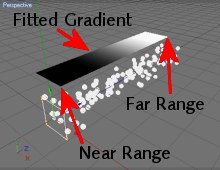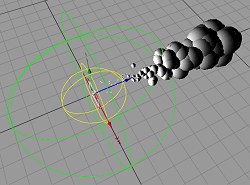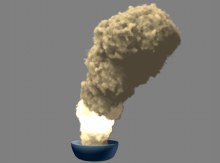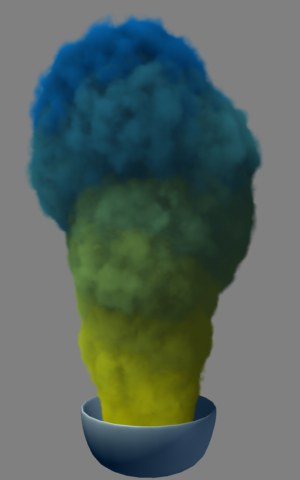Distance
PyroCluster offers many possibilities for creating smoke and cloud effects.
One of the most powerful effects that PyroCluster has to offer is the ability to influence particles based on their distance from their respective emitter.
With these settings, you can have puffs change their color, radius and luminosity according to how far away they are from the emitter.
Here you can change the color, radius and luminosity of puffs depending on how far away they are from the emitter. This is useful for effects where the color, shape and luminosity changes over distance such as seen in the flames of rocket boosters.
Distance effects can be calculated either from the emitter plane (left) or from the position of the emitter itself (right).
If the Use Emitter Plane option is enabled, the distance of puffs will be measured from the emitter’s plane rather than from the emitter’s origin.

The cylindrical cavity inside which distance effects take place is defined by the Near Range and Far Range values.
These two values define the size of the cylindrical cavity in which puffs will be influenced. Puffs in this cavity may have their color, radius and luminosity adjusted using the gradients on this page. If you want the gradients to control puffs the moment they are emitted, set Near Range to 0.
If Near Range is set to 0, the parameters will be blended right away - when the particles are born. A value of 50 will result in the particles first being blended when they are more than 50 units from the emitter. All particles within 50 units from the emitter will be drawn as puffs using the defined start settings (color at left of gradient, start radius). Particles farther than 50 units from the emitter will be interpolated between the Near and Far Range (Start and End) values.
The part of the sphere inside which distance effects take place is defined by the Near Range and Far Range values.
These two parameters define the radii of two concentric spheres placed around the emitter; together they define a cavity within which distance effects can be applied. Puffs in this cavity between the inner and outer spheres may have their color, radius and luminosity adjusted according to how far away they are from the inner sphere. If you want the gradients to control puffs the moment they are emitted, set Near Range to 0.
A Far Range of 100 would cut off the blending of parameters as soon as the particles are 100 units away from the emitter. All particles farther than 100 units from the emitter will be drawn as puffs using the defined end settings (color at right of gradient, end radius). Particles within 100 units of the emitter will be interpolated between the Near and Far Range (Start and End) values..
The radius gradient defines the puff’s radius based on the particles’ distance to the emitter. The left end of the gradient defines the puff’s near range radius. The right end of the gradient defines the puff’s far range radius.
 Editor view
Editor view Distance radius gradient.
Distance radius gradient.These gradients control the radius and luminosity of puffs depending on their distance from the inner cylinder wall. The left edge of the gradient represents the Near Range value, the right edge represents the Far Range value. A white color on the gradient means the puffs will stay the same size or luminosity. A black color means zero radius or no luminosity, while gray values are intermediate values.
The left end of the gradient represents the Near Range, the right the Far Range. This effect can be used when creating heat or burning effects.
In the image below, the radial Distance Effect is shown. The inner sphere (yellow) represents the Near Range (left end of gradient) and the outer, darker sphere represents the Far Range (right end of gradient).

Study the examples below to better understand the influence the Luminance gradient has.






The examples show how areas that glow (100% additive) correlate to the white areas of the gradient. This is a very useful option for simulating the blast of a rocket engine or similar fiery effects.
If you have not done so already, go ahead and read Working with PyroCluster.
With the Color Mix and Color gradients you can control how the color of puffs in the cavity should change. As with the Radius and Luminosity gradients, the left edge of the gradient represents the Near Range value, the right edge represents the Far Range value.
The color defined by the Color gradient is mixed with the base color of puffs, as defined on the Globals page. The Color Mix gradient controls how these two colors are mixed. White means only the color of the puffs inside the cavity is used, while black means only the base color is used; with gray values, these two colors are mixed.
In addition, the Color gradient includes an alpha gradient that enables you to control the opacity of puffs in the cavity
A pure white (RGB:255,255,255) will result in the voxel being colored to 100% with the distance gradient’s color. The global page’s initial color will not be added. All grayscale values in-between will be a mix of both colors.
The color mixer effect (i.e. how the voxel’s base color is mixed with the distance gradient) is in turn dependent on the distance a particle lies from the emitter.
With the Color gradient you have two gradients in one. A gradient controls the color (left) while another controls the transparency (right) of puffs in the cavity.
With the Color Mix and Color gradients you can control how the color of puffs in the cavity should change. As with the Radius and Luminosity gradients, the left edge of the gradient represents the Near Range value, the right edge represents the Far Range value.
The color defined by the Color gradient is mixed with the base color of puffs, as defined on the Globals page. The Color Mix gradient controls how these two colors are mixed. White means only the color of the puffs inside the cavity is used, while black means only the base color is used; with gray values, these two colors are mixed.
In addition, the Color gradient includes an alpha gradient that enables you to control the opacity of puffs in the cavity.




As you can see in the example above, the distance gradient can also alter the volume’s transparency (density) according to distance. This is done by the alpha gradient. This lets you easily transform dark, oily smoke to transparent steam.